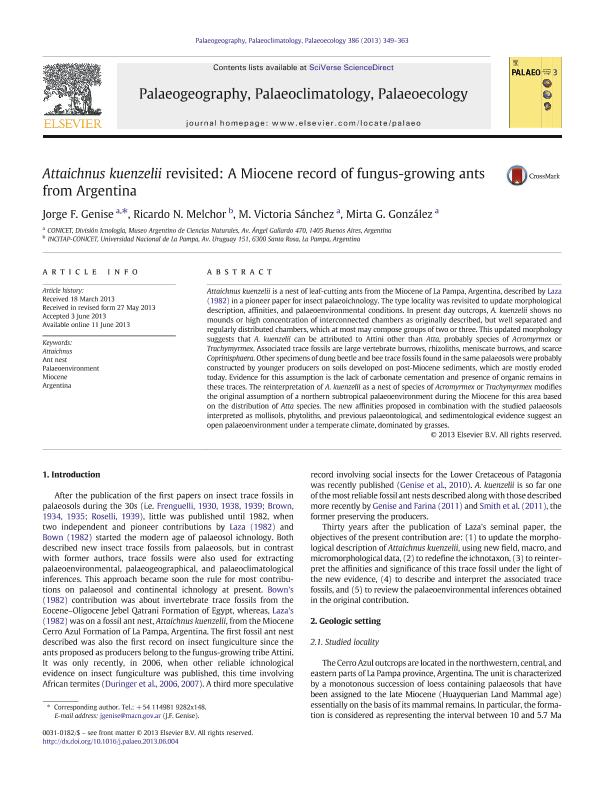Mostrar el registro sencillo del ítem
dc.contributor.author
Genise, Jorge Fernando

dc.contributor.author
Melchor, Ricardo Nestor

dc.contributor.author
Sánchez, María Victoria

dc.contributor.author
Gonzalez, Mirta Gladys

dc.date.available
2015-12-21T17:52:22Z
dc.date.issued
2013-09-15
dc.identifier.citation
Genise, Jorge Fernando; Melchor, Ricardo Nestor; Sánchez, María Victoria; Gonzalez, Mirta Gladys; Attaichnus kuenzelii revisited: A miocene record of fungus-growing ants from argentina; Elsevier Science; Palaeogeography, Palaeoclimatology, Palaeoecology; 386; 15-9-2013; 349-363
dc.identifier.issn
0031-0182
dc.identifier.uri
http://hdl.handle.net/11336/3112
dc.description.abstract
Attaichnus kuenzelii is a nest of leaf-cutting ants from the Miocene of La Pampa, Argentina, described by Laza (1982) in a pioneer paper for insect palaeoichnology. The type locality was revisited to update morphological description, affinities, and palaeoenvironmental conditions. In present day outcrops, A. kuenzelii shows no mounds or high concentration of interconnected chambers as originally described, but well separated and regularly distributed chambers, which at most may compose groups of two or three. This updated morphology suggests that A. kuenzelii can be attributed to Attini other than Atta, probably species of Acromyrmex or Trachymyrmex. Associated trace fossils are large vertebrate burrows, rhizoliths, meniscate burrows, and scarce Coprinisphaera. Other specimens of dung beetle and bee trace fossils found in the same palaeosols were probably constructed by younger producers on soils developed on post-Miocene sediments, which are mostly eroded today. Evidence for this assumption is the lack of carbonate cementation and presence of organic remains in these traces. The reinterpretation of A. kuenzelii as a nest of species of Acromyrmex or Trachymyrmex modifies the original assumption of a northern subtropical palaeoenvironment during the Miocene for this area based on the distribution of Atta species. The new affinities proposed in combination with the studied palaeosols interpreted as mollisols, phytoliths, and previous palaeontological, and sedimentological evidence suggest an open palaeoenvironment under a temperate climate, dominated by grasses.
dc.format
application/pdf
dc.language.iso
eng
dc.publisher
Elsevier Science

dc.rights
info:eu-repo/semantics/openAccess
dc.rights.uri
https://creativecommons.org/licenses/by-nc-nd/2.5/ar/
dc.subject
Attaichnus
dc.subject
Ant Nests
dc.subject
Palaeoenvironment
dc.subject
Miocene
dc.subject.classification
Paleontología

dc.subject.classification
Ciencias de la Tierra y relacionadas con el Medio Ambiente

dc.subject.classification
CIENCIAS NATURALES Y EXACTAS

dc.title
Attaichnus kuenzelii revisited: A miocene record of fungus-growing ants from argentina
dc.type
info:eu-repo/semantics/article
dc.type
info:ar-repo/semantics/artículo
dc.type
info:eu-repo/semantics/publishedVersion
dc.date.updated
2016-03-30 10:35:44.97925-03
dc.journal.volume
386
dc.journal.pagination
349-363
dc.journal.pais
Países Bajos

dc.journal.ciudad
Amsterdam
dc.description.fil
Fil: Genise, Jorge Fernando. Consejo Nacional de Investigaciones Científicas y Técnicas. Oficina de Coordinación Administrativa Parque Centenario. Museo Argentino de Ciencias Naturales; Argentina
dc.description.fil
Fil: Melchor, Ricardo Nestor. Consejo Nacional de Investigaciones Científicas y Técnicas. Instituto de Ciencias de la Tierra y Ambientales de La Pampa; Argentina
dc.description.fil
Fil: Sánchez, María Victoria. Consejo Nacional de Investigaciones Científicas y Técnicas. Oficina de Coordinación Administrativa Parque Centenario. Museo Argentino de Ciencias Naturales; Argentina
dc.description.fil
Fil: Gonzalez, Mirta Gladys. Consejo Nacional de Investigaciones Científicas y Técnicas. Oficina de Coordinación Administrativa Parque Centenario. Museo Argentino de Ciencias Naturales; Argentina
dc.journal.title
Palaeogeography, Palaeoclimatology, Palaeoecology

dc.relation.alternativeid
info:eu-repo/semantics/altIdentifier/doi/http://dx.doi.org/10.1016/j.palaeo.2013.06.004
dc.relation.alternativeid
info:eu-repo/semantics/altIdentifier/url/http://www.sciencedirect.com/science/article/pii/S0031018213002782
Archivos asociados
